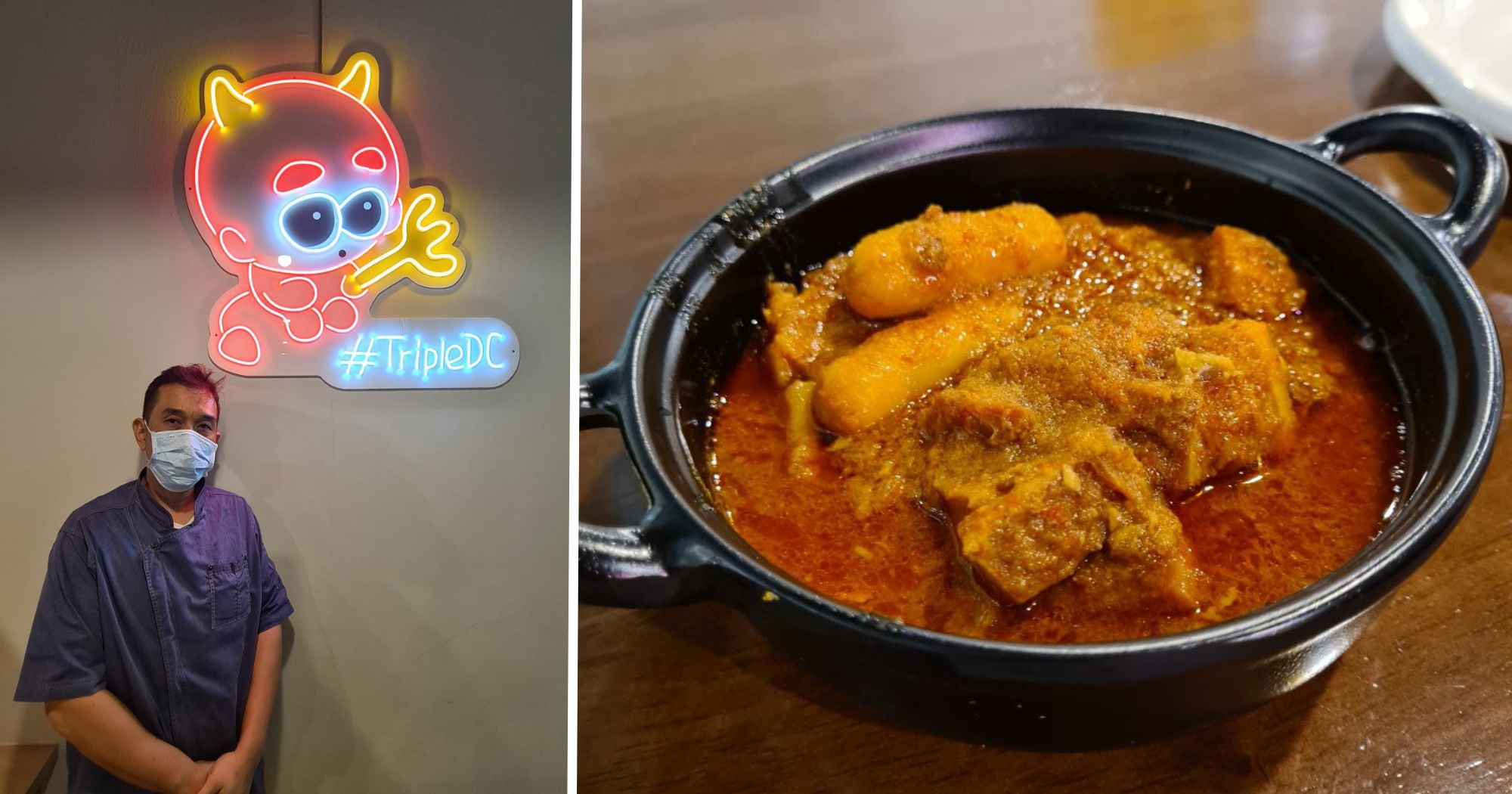Follow us on Telegram for the latest updates: https://t.me/mothershipsg
A delicate aroma of spices filled my senses as I sank my teeth into the tenderness of the pork belly within the Devil's Curry; the fiery red curry sauce stared back at me, daring me to try it.
Nestled in the corner of City Gate, Doris’s Devilishly Delicious Curry (Or Triple DC for short), greeted me with an invigorating welcome as soon as I stepped into its cosy premises.
 Images by Claire Teo
Images by Claire Teo
It wasn’t long before I began to settle into the quiet comfort of the restaurant which is owned by two friends, Justin Teh and Lin Sheng Yen.
“I’m glad you appreciate this Devil’s Curry,” Teh remarked with a warm smile, as I revelled in the rich flavours of the traditional Eurasian cuisine.
Being of Portuguese and Malaccan descent (the Serani), this is a dish that Teh holds close to his heart, pouring his heart and soul into preparing it, just like his grandmother used to.
Growing up with Devil’s Curry
As a child, Teh often looked forward to a special occasion in December.
During Christmas, his family would gather around the dining table for a scrumptious meal, which included one of Teh’s all-time favourites – the Devil's Curry – made by his grandmother.
Since it was only once a year that Teh could enjoy the Devil's Curry, he savoured every last morsel of the delectable treat, enjoying the rich flavours as it filled his mouth.
“It was one of the dishes I always wanted to eat, so I kept pestering the elders to cook it more often,” Teh mused as he relished in the memory of his childhood.
Teh was frequently told to wait till Christmas since the dish is highly labour-intensive to prepare.
But, on rare occasions, when the elders did give in to him, Teh vividly remembers devouring the dish at every meal until the entire pot was emptied.
“Why was Devil’s Curry served only during Christmas?” I asked curiously.
“That’s the tradition”, Teh replied with a smile.
“It’s like having turkey for Christmas,” Lin quipped.
For Teh, the taste of Devil's Curry is one he grew up loving and its fragrance brings back nostalgic memories of the joyous festive season.
“It reminds me of Christmas parties, Christmas dinners,” Teh reminisced with a slight glimmer in his eyes.
as he reflected upon the sweet memories of his childhood and the fast-disappearing Eurasian culture — more specifically, the heritage of the Serani people.
The history of Devil’s Curry and one man's mission to safeguard his grandmother’s recipe
Devil's Curry, or kari debal (meaning leftovers), is a traditional dish that has early origins in the 1500s when sailors cooked leftover meat in a spice mix for consumption.
Over the years, the Devil's Curry was served as a post-Christmas party dish that consisted of leftovers from the Christmas party. However, it soon became so popular that the dish quickly became one of the holiday favourites.
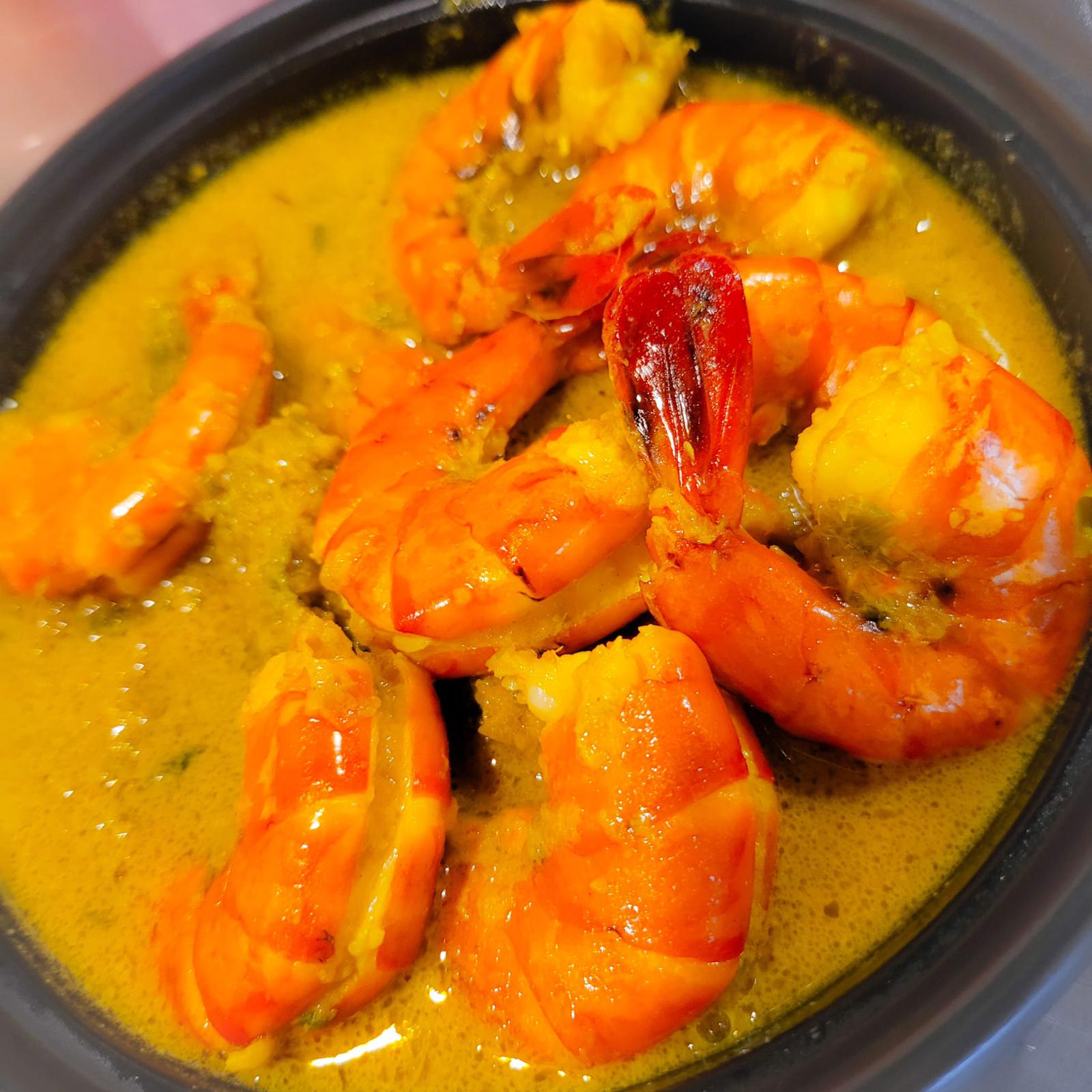 Triple DC's Prawn Bostador.
Triple DC's Prawn Bostador.
“People did not want to wait for Boxing Day so they started buying meat to cook this dish. It transitioned from having a very practical purpose (of reducing food waste) to becoming a favourite,” explained Teh, adding that as the recipe for the dish evolved with time, each family developed their own style of cooking.
For Teh, his grandmother’s recipe consists of pork belly and loin along with soft bacon bones within the curry; the dish does not contain greens as his grandmother preferred meat to vegetables.
Sadly, Devil's Curry is rapidly disappearing from the culinary landscape, particularly among the younger generation, said Teh:
“In my generation, I’m the only one who bothered to learn to cook Devil’s Curry. There are a lot of customers who come in, of Eurasian heritage, who have not eaten it for years because they have never learned. Even my grandma did not pass on a lot of the other recipes that she had."
Aside from preserving his grandmother's recipes, Teh believes that such culinary delights are worth sharing and hopes that they would one day become a mainstay in the Singapore food scene.
From golf course manager to restaurant owner
Teh and Lin established their first-ever restaurant, TripleDC, in May 2021, amidst the Covid-19 outbreak. The restaurant is named after Teh’s late grandmother and was started to preserve her recipes.
But more than that, Teh, who gave up his career as a golf course manager, wants to preserve Eurasian heritage
“I wanted to do more in life, I wanted to make this world a better place. Through running a restaurant, you can do some philanthropy and create job opportunities. Growing good grass (as a golf course maintenance manager) is fun but we are only catering to an elite minority.
The Eurasian culture and heritage is also diluting. We must preserve it.”
And hence, in May 2021, as the number of Covid-19 cases appeared to stabilise and the F&B industry showed signs of recovery, the duo decided it was finally time to launch their new business.
But, it hasn't been all roses for the owners since opening the restaurant. Teh and Lin have also had to deal with hardships, challenges, and sacrifices along the way.
Poor business due to low customer footfall
According to Teh, the restaurant struggled to find customers in the first five months, and they had to bear losses. But over time, business started to improve for the duo.
“We’ve had quite a few dine-in customers so far. At first, probably none came. Beyond that, we’ve had quite a lot of approval,” said Teh.
Despite that, Teh confessed that his business is barely breaking even and had only recently started making a small profit.
As City Gate is a lesser-known mall located on the fringes of Bugis, Lin admitted that drawing patrons to the restaurant remains a challenge.
Teh also attributed the low diner count to the lack of knowledge about the Eurasian cuisine, among the general public.
“We’ve had quite a few people who come by and actually ask ‘what is Eurasian?’ so that alone says a lot”.
From distributing flyers on overhead bridges to connecting with the public on social media platforms, Teh and Lin have worked tirelessly to promote their restaurant since its opening. They hope to shed light on the richness of the Eurasian heritage through the food served in the restaurant.
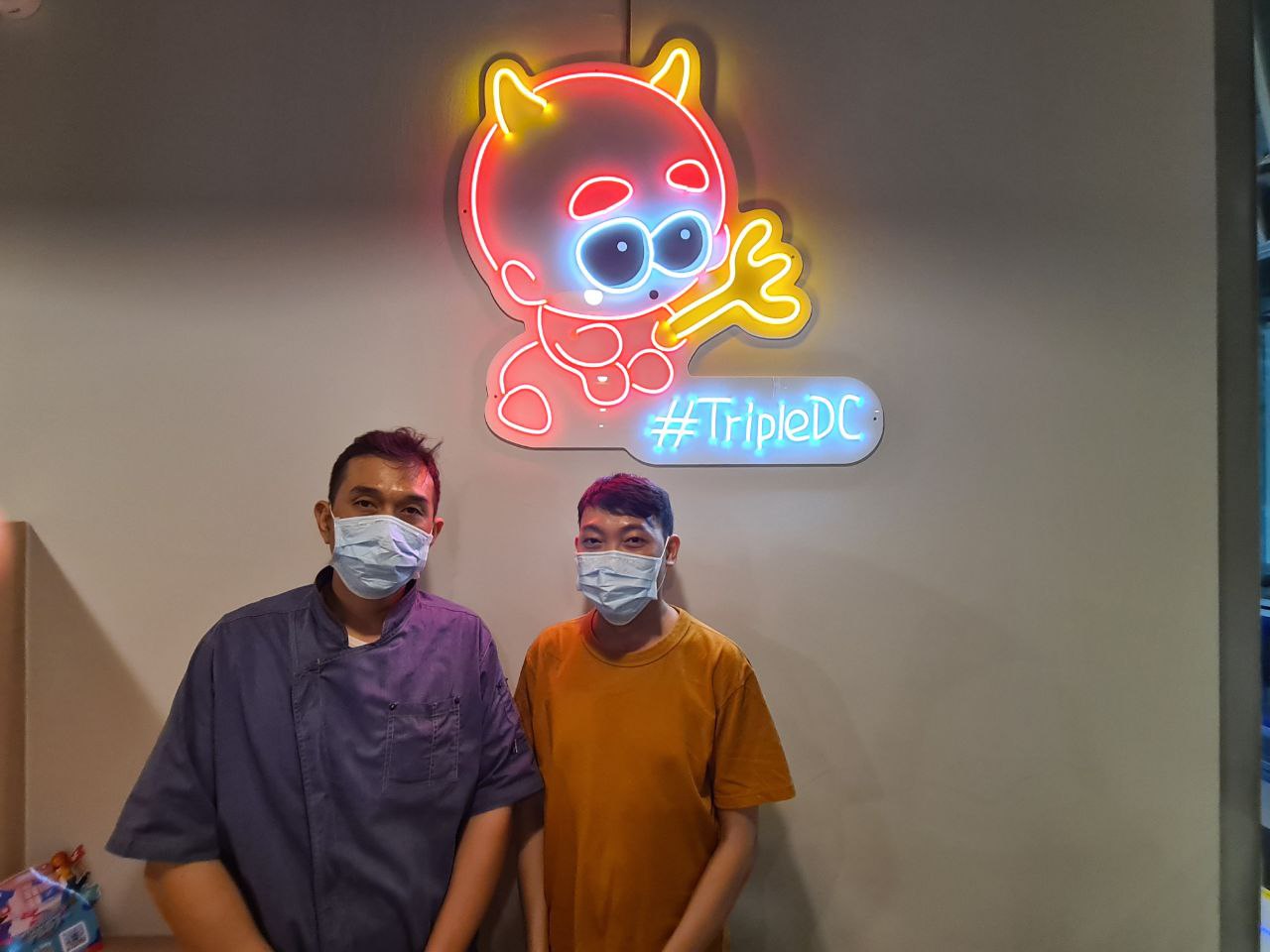 Justin Teh and his business partner Lin Sheng Yen. Image by Joshua Lee.
Justin Teh and his business partner Lin Sheng Yen. Image by Joshua Lee.
Teh said:
“I used to go up onto the overhead bridge and give out flyers and one of the things I used to say was ‘I don’t know if you’ll like it but it’s worth a try and if not, at least you’ll know that the Devil’s Curry dish exists.'"
Through these uncertain times, Teh recognised that there are instances when he wished he could return to the comforts of a regular 9-5 job.
“I wouldn’t lie to you, you definitely will feel like: Can we make it? Is this worthwhile? What am I doing here? Was this all too much to ask? But we have to try”.
“It’s very hard when you cook with all your heart and try to produce something that you feel is very valuable and nobody comes to eat it. You start to doubt that you’ll ever make it,” Teh continued.
Commitments and sacrifices
In the process of running his business, Teh acknowledged that he has had to make many personal sacrifices that he did not have to undertake at his former employment.
When asked to list some of these sacrifices, Teh exclaimed without hesitation, “Sleep!”
Since the preparation of Devil's Curry takes an average of five to six hours, Teh’s day begins extremely early at around 5.30am almost every day, leaving him with little time to rest and recharge as his restaurant operates till 9.30pm.
The outdoor enthusiast also revealed that he has had to cut back on some of his hobbies since the opening of the restaurant.
“I am a very outdoor guy, I love to fish, I love to play tennis, I love to play golf. I can’t do anything of that sort now. We only have one off day a week, and I’m too tired to do anything,” Teh stated, adding that he hopes to build up his business to a point where he can hire a team of chefs to assist in the kitchen.
Tiring but fulfilling
Although running the restaurant has been challenging for the duo, they have also found a silver lining.
Receiving many positive responses from their customers and seeing a gleam of appreciation in their patrons’ eyes as they indulge in the various dishes have encouraged Teh and Lin to push on through the difficult times.
Teh is grateful for this support:
“Now and then, we see a glimmer of hope. We’ve had people who encourage us, who say very nice things.”
Some customers have even responded emotionally to the TripleDC's Devil's Curry because of its nostalgic taste, and witnessing these emotions has been extremely heartwarming for the owners.
“We have encountered a couple of emotional responses – one of them was because it reminded him of his late mother… another one was this lady who was reminded of her grandmother’s cooking and she also hadn’t eaten Devil's Curry for a very long time – they get quite emotional, you can see the emotion and that’s also very rewarding”.
The owners recognised that these moments have strengthened their commitment to preserving Eurasian culture through their restaurant, bringing them a profound sense of fulfilment and joy.
The making of Devil’s Curry: A tedious process
The preparation of Devil's Curry is a multi-step process that requires considerable patience and commitment.
It begins with grinding the rempah (spice paste) to a uniform consistency and texture – a step that can take up to half a day without the proper equipment.
Teh is particularly thoughtful about the spice level. I came to learn that he takes the time to remove chilli seeds so that his customers can enjoy the spicy Devil’s Curry without hurting their stomachs (traditionally, Devil's Curry is made so spicy, it's almost masochistic).
 Image by Joshua Lee
Image by Joshua Lee
For Teh, he uses a commercial-grade grinder to speed up the process, taking him about an hour to grind 30 litres of the rempah.
The next step is to de-brine the meat, before cutting it up and starting the cooking process proper.
As part of the cooking process, the rempah is first fried until it reaches a certain degree of doneness before Teh tosses in the meat and continues the frying process long enough for the flavours to meld in a rich blend.
“You have to start slow, you have to take your time to get the process right. You cannot rush the frying process, you need to be patient.”
Subsequently, water is added to the dish, and the ingredients are boiled until the meat is tender.
Teh repeats this process routinely on an almost-daily basis, taking him about five to six hours each time — a laborious and time-consuming task, to say the least — and his efforts are evident in the exquisite flavour of his Devil's Curry.
Dining in at Triple DC
Well, that's all good, but what of the food? To experience the restaurant’s Eurasian cuisine for ourselves, we ordered the iconic Devil's Curry (S$10/S$35) along with some Grago Cutlets (S$9 for three).
 Image by Claire Teo
Image by Claire Teo
As soon as the piping hot Devil's Curry was served, a distinctive fragrance wafted through the air, whetting my appetite.
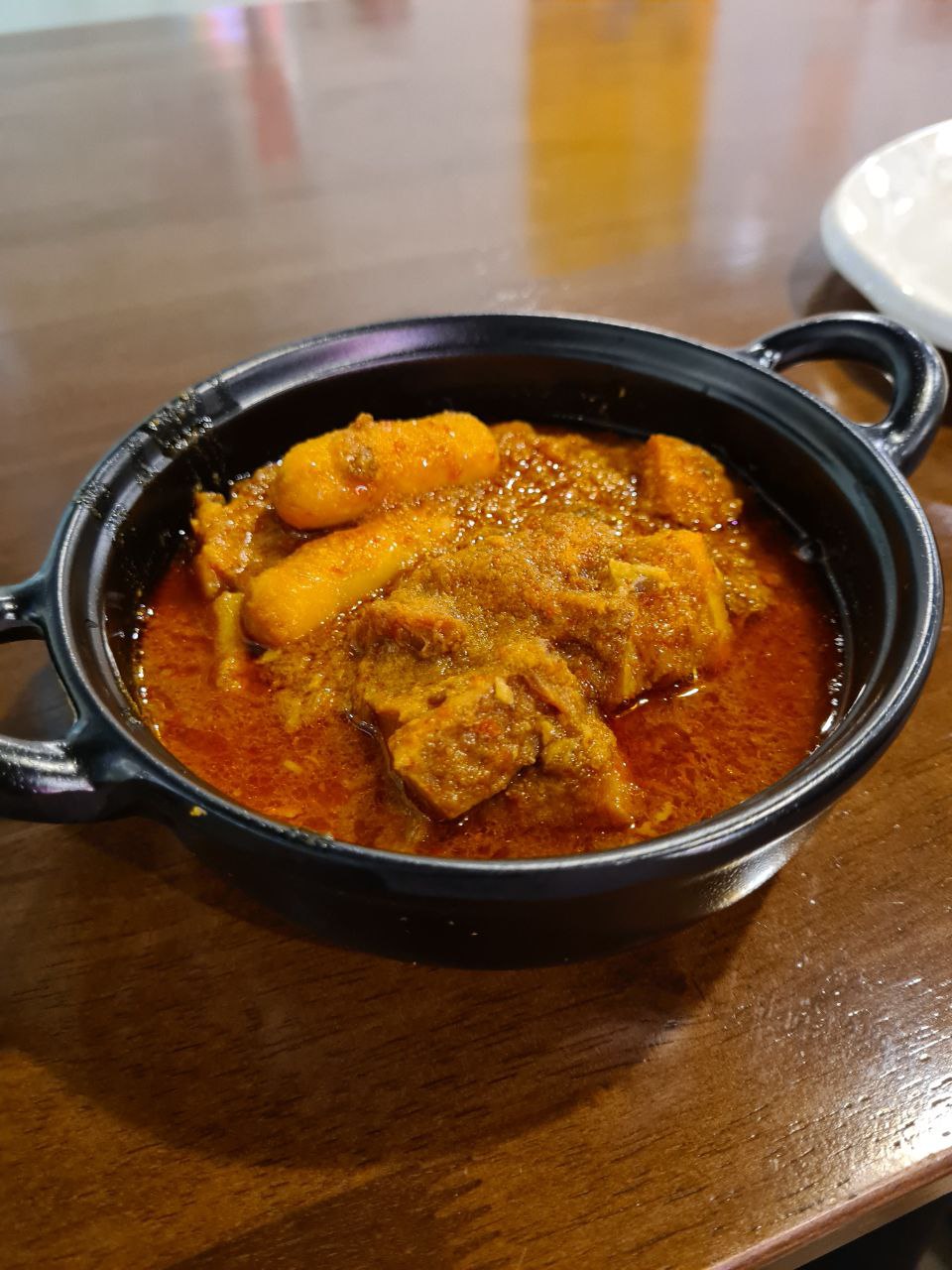 by Joshua Lee
by Joshua Lee
Initially, I thought the Devil's Curry would be similar in taste to the chicken curry that my grandmother often makes for dinner. But, upon taking a sip of the curry, I realised that it was unlike any other curry I had ever tasted.
As I sampled the dish, my senses were overwhelmed by the exotic taste.
The curry's thick consistency resembled a stew and the pork within the dish was infused with different spices, giving it a savoury flavour, reminiscent of the Italian smoked duck which I enjoy, although I would have preferred the meat to be slightly softer.
Having a low tolerance for spice, I opted for the mild version of the Devil's Curry.
I did, however, sample the spicy version of the curry and found the spiciness to be more of a warm, soothing sensation that lingered on the back of the throat — ironically, this aspect of the dish was what I enjoyed most.
For the price, I felt that the portion was quite generous too.
It is relatively cheaper than other Eurasian restaurants in Singapore (S$10 for a small portion at TripleDC compared to S$30.80 for a similar-sized portion at Eurasian restaurant, Quentin's)
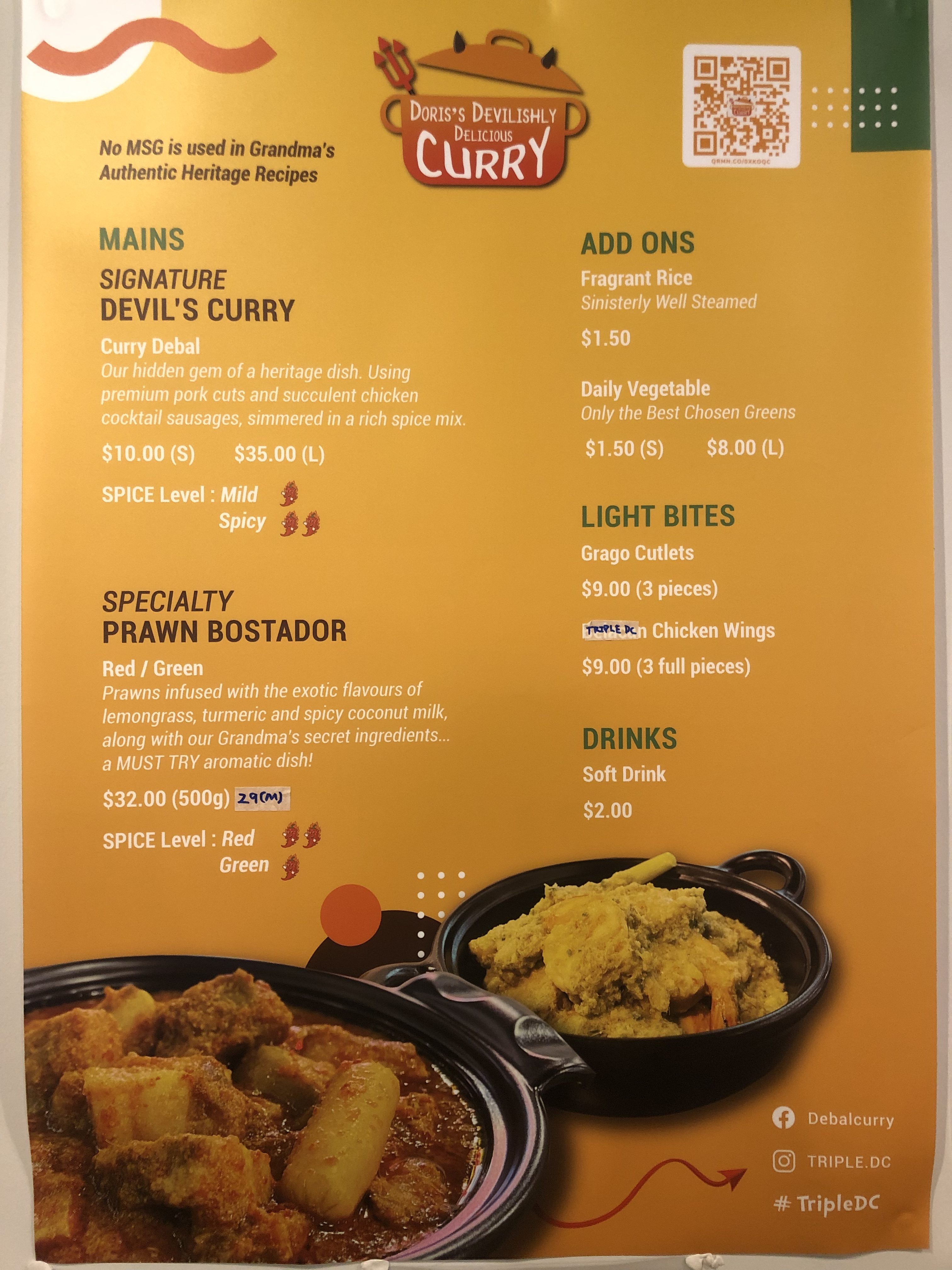 Image by Claire Teo
Image by Claire Teo
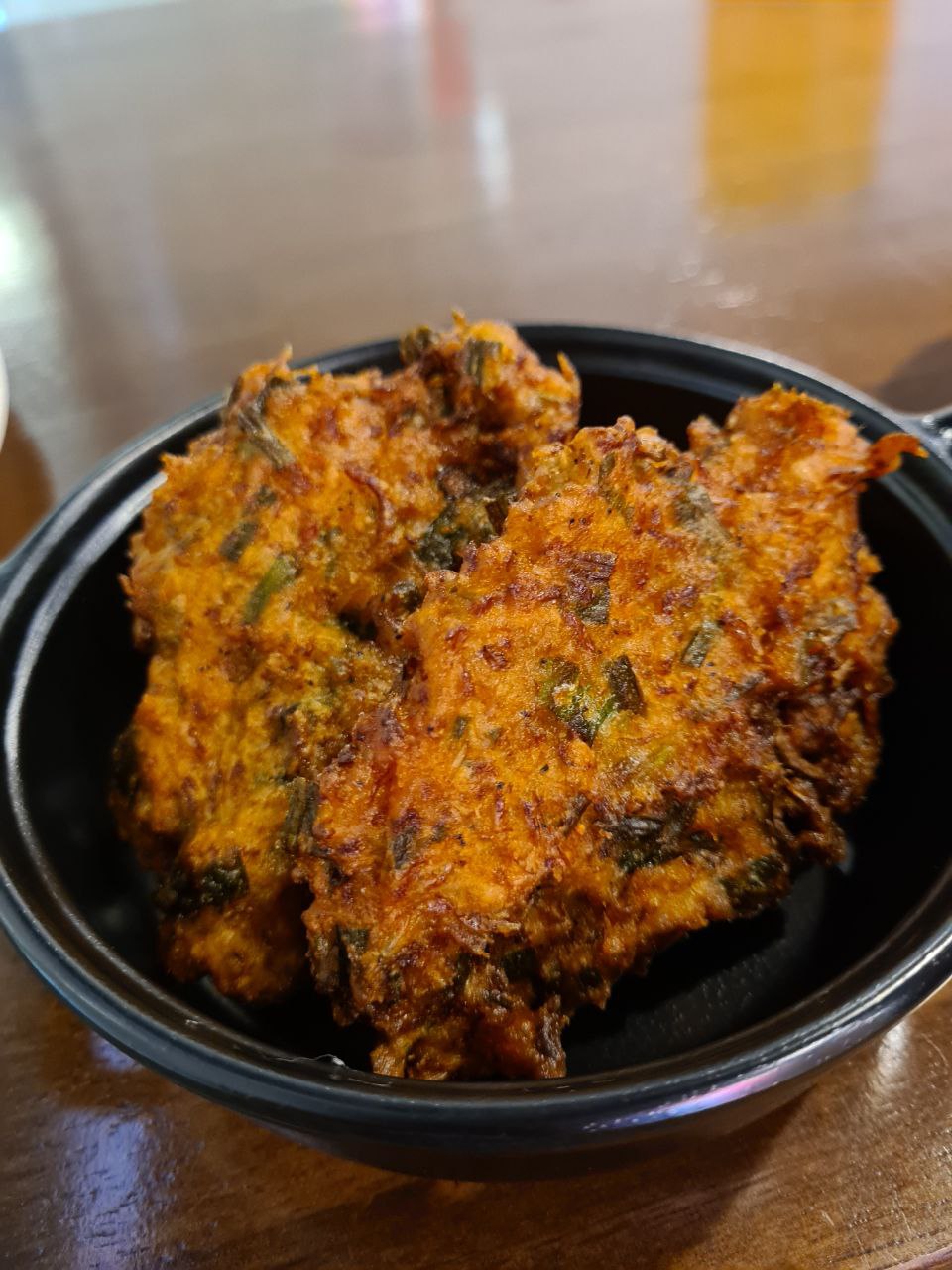 By Joshua Lee
By Joshua Lee
"Grago" is the Kristang word for krill or tiny shrimp.
The Grago Cutlets were filled with krill. They reminded me of my childhood snack, prawn crackers, along with the chewy and spongy texture of Fuzhou fried oyster cakes.
Furthermore, some colleagues also compared the cutlets to a traditional Indian fritter, vadai.
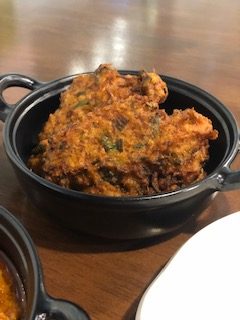 Image by Claire Teo
Image by Claire Teo
Satisfied with the meal, I looked up at Teh who smiled back at me.
"Do you think you have successfully preserved Eurasian heritage?" I asked.
To that, he replied:
“We are only beginning to make a small tiny dent in the mission”.
He hopes that more people will support him in his quest to preserve Eurasian cuisine through Triple DC.
Doris's Devilishly Delicious Curry is located at 371 Beach Rd, #01-27, Singapore 199597. You can follow the restaurant on Facebook for updates.
Follow and listen to our podcast hereIf you like what you read, follow us on Facebook, Instagram, Twitter and Telegram to get the latest updates.
